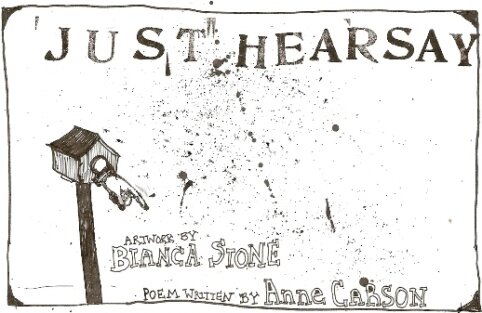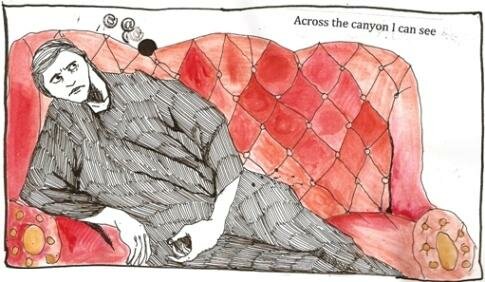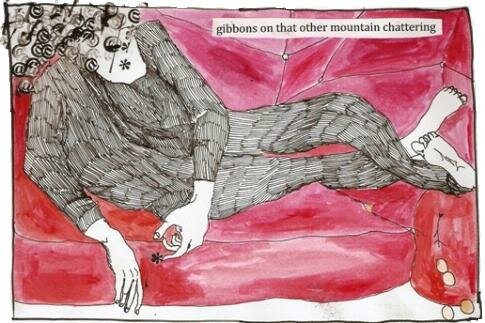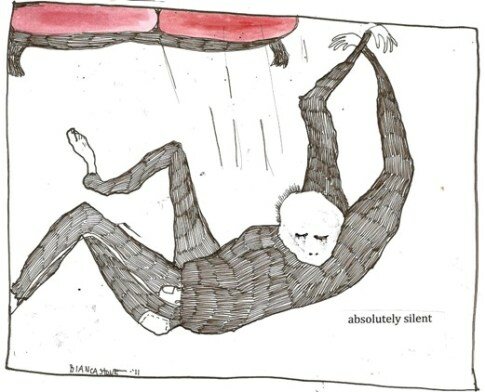Thin Kimono is a book of mistaken identities: a hallucinogenic wandering through a cocktail party the night before the invention of the internet. The party is populated with individuals you may or may not know. Your wife is a slightly altered version of herself. There are horses, but even they have become something else. Michael Earl Craig’s acupuncturist is here too. She tells us her “speakers are hidden in the jade plant” (The Bad Clown) We get the sense she is struggling not to become evil. We know there must be separate rooms, separate poem-rooms, but even with titles, often the only sense of demarcation comes from the turning of pages. This is particularly true in the book’s second and smallest section, which is reminiscent of Matthew Rohrer’s “A Plate of Chicken” in that the section is comprised of short 8-line segments separated by asterisks (“A Plate of Chicken” is divided into 7-line segments). Also like “A Plate of Chicken,” this section employs an uncanny use of dissociative observation as lens for self-reflection.
The innervated spatula, it
feels things even you don’t.
In 204 a couple humps briskly
like Great Danes, it’s textbook (had heard
what was probably a shoe hit the wall
with some force). We dream of perfecting life
somewhere else. In space, let’s say.
Wearing Erik Satie stretch pants.
We are invited to enter the rooms of his characters, to observe their strange habits and quiet respect for the divinity in objects, and then we let them pass back into an interaction we can only assume continues to occur after our leaving. “The nitwit danced with the congresswoman/ at the spring picnic,” Craig writes in “Poem.” As a reader I take solace in the knowledge that this dance continues even once I have closed the book and replaced it on my bookshelf. I’m equally glad to know that couple in 204 will be humping eternally, briskly.
In “The Neighbor,” one of the book’s most defiant and arguably self-aware poems, a dinner roll falls off the dining room table. “It [rolls] across the room and [passes] through the doorway into the bedroom and the door [slams] shut behind it.” Nothing about this act is portrayed as being out of the ordinary. To the contrary, we feel a very natural loss at the roll’s leaving, as though we, the non-participatory readers, have done something to cause it to throw a tantrum. After all, this particular poem is about us: about Craig’s inability to imagine us as anyone other than exactly himself, and of course about our inability to fulfill that expectation. Perhaps we feel an affinity to the roll in this poem because Craig has chosen the roll to represent our interests. While reading, there is always a recognition that we cannot enter the poem unless we are written into it, and so, like ghosts, we posses for a moment the body of the dinner roll and storm indignantly out of the room.
As with the proems of Francis Ponge, the objects in Thin Kimono are imbued with a kind of duplicitous consciousness. However, where Ponge’s objects come across as insecure and terrified of the softness that is contained within them, Craig’s objects appear at times in a state of revolt against the very human hands that created them. In “In The Road,” Craig tells us of a dream where he is shoeing a horse.
________________…Hitting
the nails was like trying to strike flies
from the air. My hammer flashed in the sun,
striking the shoe to the left or the right of the nail.
One miss-hit busted my thumb open.
Blood trickled like a wet glove over my hand.
Even the blood here becomes an object capable of acting of its own volition. And again, similar to the proems of Francis Ponge, there is a moment where the interior comes to the surface, transforms itself, and covers “like a glove” the exterior. The blood in this instance is no longer an extension of the body but has become more an extension of the hammer that has revolted against the body. The objects have overtaken consciousness. Our grasping at them will lead to our own demise. Here is a very clearly stated desire to turn away from our tendency toward possession of material goods and into a world of endless metaphysical fulfillment, the lucid dreamstate where surrealism and realism and absurdism all coexist.
These poems occur in the space between the stirring of consciousness and the awakening of reason, when our unconscious perceptions of the objects and characters that embody our lives are still dripping in the semiotic fluid of dreams and of language. In short, it’s a very fun book to read, and one that leaves you feeling more inquisitive and excited about the earth’s occupants (both sentient and non-sentient) than when you opened it. Craig’s poems are as layered and thick as a well-made baklava. They are equally accessible, rich, and nutty. “THE READER CAN ALMOST BE DUMB REALLY AND STILL GET [THEM].”(Bluebirds) Also like baklava, they taste more of the Country Marm’s kitchen than of the Hostess factory, more of the earth than of the machines we have created to destroy it. As with so many of the books put out by Wave, this one is quirky, intelligent, and entertaining, with leaps that sometimes require a great effort in the suspension of disbelief. I for one am glad to go there, glad to learn of the disparities that can be stitched together by consciousness, and particularly glad to again crack the form I have built around cognition. I hope this book does the same for you.


![jansen[1]](/wp-content/uploads/2011/02/jansen1.jpg)



